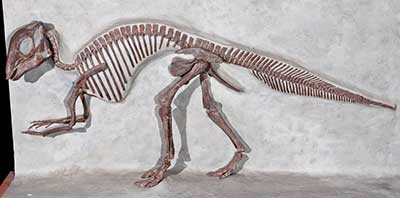Maiasaura
(MY-uh-sore-rah)
| Quick Facts | |
|---|---|
| Name Meaning: | Maia's Lizard or Caring Mother Lizard |
| Distribution: | Western U.S. (Montana) |
| Time Period: | Late Cretaceous,80 Ma |
| Length: | 30 ft. (9 m) |
| Height: | 7.5 ft (2.3 m) |
| Weight: | 1,770 lbs |
| Diet: | Herbivore |
| Linnaean Classification | |
| Kingdom: | Animalia |
| Phylum: | Chordata |
| Class: | Reptilia |
| Superorder: | Dinosauria |
| Order: | Ornithischia |
| Suborder: | Ornithopoda |
| Family: | Hadrosauridae |
| Genus: | Maiasaura |
| Cladistic Classification | |
| |

History
The Maiasaura was first discovered in 1978 by Laurie Trexler, since then hundreds of specimens have been uncovered. It was later described by Jack Horner, known for his work as the paleontologic advisor for the Jurassic Park movies, and Robert Makela. It was named Maiasaura because of the nests found in the Two Medicine Formation of western Montana, which has become known as the Egg Mountain. These nests contained several Maiasaura young that had already hatched. The Maiasaura was identified as a dinosaur that cared well for its young, thus its name the "caring mother lizard." Since its discovery at least 200 specimens of Maiasaura have been found of all age groups.Description
The Maiasaura was very similar to others of its kind. It had a broad, duck-like beak with strong muscular jaws like other duck-billed dinosaurs. One unique feature was its crest located in front of its eyes. Also like others of its kind it could walk on four legs, but lift itself on two legs for sudden bursts of speed. This would have been useful as the Maiasaura would have had little way of defending itself, except perhaps by using its strong heavy tail or by traveling in herds.Lifestyle
There is overwhelming evidence that the Maiasaura traveled in large herds in North America. Some of these herds would have been ten-thousand strong. It is believed that these herds traveled from the north to the south and back with the seasons. These numbers and size would have served as a protection from Tyrannosaurids and other predators. The crest may have been used for headbutting contests with others of its own kind. Maiasaura females were good nurturers. They would travel to a nesting site and lay 20 or so sausage shaped eggs close together. They would cover these eggs and stay close by until they hatched. Evidence shows that the teeth of some of the newborns would be worn, which means that the mothers probably brought them food before they were strong enough to leave the nest and eat on their own.
ScienceViews Writer: Jason Hamilton.
Copyright © 2005-2010 Calvin & Rosanna Hamilton. All rights reserved.